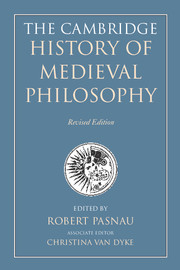Book contents
- Frontmatter
- Contents of Volume 1
- Preface
- List of contributors
- Frontmatter
- Contents of Volume 2
- Introduction
- I Fundamentals
- II Logic and language
- III Natural philosophy
- 16 Natural philosophy in earlier latin thought
- 17 Creation and causation
- 18 The influence of arabic aristotelianism on scholastic natural philosophy: projectile motion, the place of the universe, and elemental composition
- 19 Change, time, and place
- 20 The nature of change
- IV Soul and knowledge
- V Will and desire
- VI Ethics
- VII Political philosophy
- VIII Metaphysics
- IX Theology
- Appendices
- Bibliography of primary sources
- Bibliography of secondary sources
- Index nominum
- Index rerum
- References
18 - The influence of arabic aristotelianism on scholastic natural philosophy: projectile motion, the place of the universe, and elemental composition
from III - Natural philosophy
Published online by Cambridge University Press: 05 August 2014
- Frontmatter
- Contents of Volume 1
- Preface
- List of contributors
- Frontmatter
- Contents of Volume 2
- Introduction
- I Fundamentals
- II Logic and language
- III Natural philosophy
- 16 Natural philosophy in earlier latin thought
- 17 Creation and causation
- 18 The influence of arabic aristotelianism on scholastic natural philosophy: projectile motion, the place of the universe, and elemental composition
- 19 Change, time, and place
- 20 The nature of change
- IV Soul and knowledge
- V Will and desire
- VI Ethics
- VII Political philosophy
- VIII Metaphysics
- IX Theology
- Appendices
- Bibliography of primary sources
- Bibliography of secondary sources
- Index nominum
- Index rerum
- References
Summary
Most popular accounts of the introduction of Aristotle’s natural philosophy credit Arabic civilization with transmitting classical Greek works to the Latin West. By contrast, a few contemporary authors, hostile to Islam, deny any contribution of the Islamic world to scholasticism. Neither claim is credible. As we shall see, although Arabic Aristotelianism did not provide the primary access to Aristotle’s texts themselves, it did make a profound contribution to scholastic natural philosophy.
Confounding this dispute is a misunderstanding of the significance of Arabic-based Aristotle translations. Scholastic authors seldom commented on translations based on the Arabic Aristotle. Almost every major scholastic commentary on Greek philosophical works is based on a direct translation from Greek into Latin, with a few early exceptions. Scholastics evidently recognized that though they were often harder to follow and more obscure than translations from the Arabic Aristotle, Greek-based translations were closer to the original.
So let us look chiefly at the influence of the interpretative tradition of Arabic Aristotelianism on the Latin West, after saying a few words on translations of Arabic texts. We will suggest that though scholastics did not comment on Arabic-based translations of Aristotle, without these translations and more importantly without the interpretative tradition that accompanied them, the scholastic tradition would have been much poorer; indeed, it might never have arisen. After all, James of Venice’s translations had been available since about 1150, but Aristotelian analytics, metaphysics, and natural philosophy began to influence major scholastic authors only when the Michael Scot translations became available around 1225.
- Type
- Chapter
- Information
- The Cambridge History of Medieval Philosophy , pp. 247 - 266Publisher: Cambridge University PressPrint publication year: 2014



